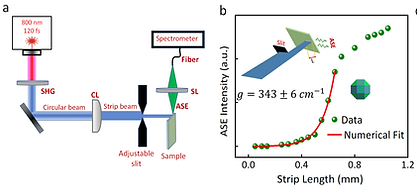
Research Interest
I am interested in "coherent, incoherent light-matter interactions and many-body quantum correlation effect in two-dimensional materials, their twisted heterostructures, and perovskite nanocrystals"
Research Highlights



Here, we report the design strategy of facet engineering to reduce the gain threshold of amplified spontaneous emission by manyfold in NCs of the same concentration and edge length. We achieved this hallmark result by controlling the Auger recombination rates dominated by processes involving NC volume and thermalization time to the emitting states by optimizing the number of facets from 6 (cube) to 12 (rhombic dodecahedron) and 26 (rhombicuboctahedrons) in CsPbBr3 NCs. For instance, we demonstrate a 2-fold reduction in Auger recombination rates and thermalization time with increased number of facets. The gain threshold can be further reduced ∼50% by decreasing the sample temperature to 4 K. Our systematic studies offer a new method to reduce the gain threshold that ultimately forms the basis of nanolasers.

Here we report the first room-temperature observation of the Floquet biexciton-mediated anomalous coherent excitonic OSE in CsPbBr3 quantum dots (QDs). Remarkably, the strong exciton–biexciton interaction leads to a coherent red shift and splitting of the exciton resonance as a function of the drive photon frequency, similar to Autler–Townes splitting in atomic and molecular systems. The large biexciton binding energy of ∼71 meV and exciton–biexciton transition dipole moment of ∼25 D facilitate the hallmark observations, even at large detuning energies of >300 meV. This is accompanied by an unusual crossover from linear to nonlinear fluence dependence of the OSE as a function of the drive photon frequency. Our findings reveal crucial information on the unexplored many-body coherent interacting regime, making perovskite QDs suitable for room temperature quantum devices.



We demonstrate an optically tunable giant band-gap renormalization (BGR) ∼ 1200 and 850 meV from the edge of the conduction band and complete suppression of the exciton absorption in large-area single-layer (1L) and three-layer (3L)MoS2, respectively. Further, exciton bleach recovery in 1L and 3L show a contrasting fluence-dependent response, demonstrating the layer-dependent optical tuning of exciton lifetime in a way that would be both reversible and real time.

We developed a new chemical route to synthesize core-shell nanorod and demonstrated ultrafast direct charge transfer through metal semiconductor interface.

We demonstrated ultrafast sign change of nonlinear refractive index in As2S2 thin films.